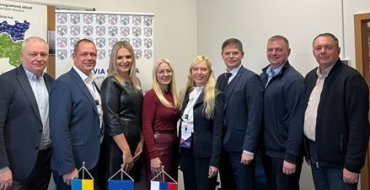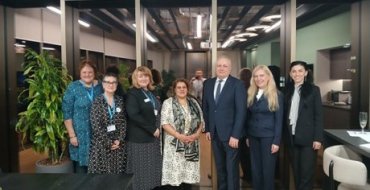International scientific project by Uzhhorod physicists and Swiss partners
Science always strives to open new horizons and reveal unknown properties of materials that can pave the way for modern technologies. In particular, research in the field of terahertz photonics, which remains largely unexplored, is important. It is in this direction that the Ukrainian-Swiss project “3D and 2D complex chalcogenides for terahertz photonics” is being implemented, which allows obtaining new valuable information about (photo)conductive, dielectric, and nonlinear optical properties of unique ferroelectric two- and three-dimensional halide single crystals in the terahertz frequency range of the electromagnetic spectrum.
Four scientists from Uzhhorod National University — representatives of the physics and chemistry departments — are involved in the initiative, as well as colleagues from Switzerland, Zurich University of Applied Sciences (ZHAW).

Oleksandr Hrabar, professor, doctor of physical and mathematical sciences, and coordinator of the above-mentioned scientific project, will tell us about its goals and significance.
– Oleksandr, can you tell us about this project and how you managed to win it?
The competition organized by the National Science Fund of Ukraine and the Swiss National Science Foundation, entitled “Joint Ukrainian-Swiss Projects for Scientific Research: Project Competition 2023,” began about two years ago and aimed to support joint research by Ukrainian and Swiss scientific groups. The topic was open, and participation was open to any institution—universities or research institutions. The main requirements were clear: the team should have only four members with candidate or doctor of science degrees, preferably with previous experience of cooperation with partners from Switzerland. In addition, the involvement of young scientists under the age of 35 and women was encouraged, in accordance with the principles of gender equality.
Our team fully met the conditions of the competition: we have been collaborating with colleagues from Switzerland since 2005–2015, we have joint articles, many years of experience, and mutual trust. It was on the basis of this long-standing partnership that the idea to submit a project arose, and so when the competition appeared, we sent an application and successfully passed the selection process. A total of 124 applications were submitted, of which 74 passed the initial review, and 20 projects were selected as winners.
I should note that initially the organizers planned to support only 15 initiatives, but later added a few more places, and fortunately, we made it into the top 20. This is a success, because only a few programs in physics were selected, the rest were in the humanities, law, medicine, chemistry, and ecology. I believe that the contemporary theme of the project played a major role, as did the significant previous achievements of our team. In addition, our Swiss colleague also had high scientific indicators: publications and a significant citation index.
In partnership with foreign groups, the key is the mutual complementarity of resources and knowledge: we provide unique classes of crystals and materials valuable for electronics, optics, and photonics, while the Swiss group provides equipment and spectroscopy techniques, particularly in the terahertz range. Although our laboratory is not as powerful as that of our colleagues, we continue to grow and study unique crystals, which are the basis for joint research and the development of new functional materials.
What are the objectives and goals of the project?
The goal of our project, “3D and 2D complex chalcogenides for terahertz photonics,” is to study crystals with very interesting properties: they are sensitive to light and electric fields, and they also have numerous effects that are used in photonics. The project's objectives include spectroscopy in the terahertz range and research into the possibilities of using these materials as active components in relevant systems. This is a relatively new and under-researched field, where few people have worked on this particular aspect.
What is the terahertz range and why is it difficult to study?
The terahertz range is the frequencies between optical and radio wave studies, intermediate between the infrared and microwave ranges. It is the least explored because it is difficult to manufacture the appropriate sources, as well as devices for signal control and registration. Special materials are required to work in this range. First, the properties of the material are studied, and then, on this basis, it can be used for generation, control, and reception in the THz range.
– How is the research progressing?
– We offered our materials, and the Swiss group had previously worked with other compounds – organic crystals. This made it possible to expand the class of materials under study: we could use our crystals, and they could master new inorganic compounds, which mutually enriched the research results.
– Who is on the Ukrainian team and what results have been achieved so far?
– As I mentioned, our team consists of four people. It includes senior researcher and associate professor of the Department of Inorganic Chemistry, Candidate of Chemical Sciences Artem Pogodin; head of the Department of Semiconductor Physics, academician of the National Academy of Sciences of Ukraine, Doctor of Physical and Mathematical Sciences Julian Vysochansky; Anton Kogutych, associate professor of the Department of Semiconductor Physics, candidate of physical and mathematical sciences; and myself, Oleksandr Hrabar, Doctor of Physical and Mathematical Sciences, professor of the Department of Semiconductor Physics and coordinator of the Ukrainian-Swiss project.
– How is the project funded?
– Funding is provided by the Swiss National Science Foundation. The funds are transferred to us through a Swiss organization. In particular, they include salaries and small amounts for the purchase of equipment. This is additional money that does not affect the university budget.
– What results has your project already achieved and when do you plan to publish them?
– There are no publications yet, as this is the first year of the project. We are accumulating materials for processing and analysis. We presented our first joint results at the European Conference on Ferroelectric Physics, which took place in Katowice, Poland, from August 31 to September 5. This conference was also an opportunity to meet with our Swiss partners, discuss the initial results, and plan further research. Of course, research into new materials requires the adaptation of experimental methods, so the work continues.
We are currently preparing for the next seminar, “Properties of Ferroelectric and Superionic Systems”, which will be held on October 23 for the 14th time and will be dedicated in particular to our scientific topic. The event is traditionally held annually, and this time it will take place in a mixed format—partly online. The results of our research will also be presented. The online format allows for effective information exchange and discussion even remotely.














